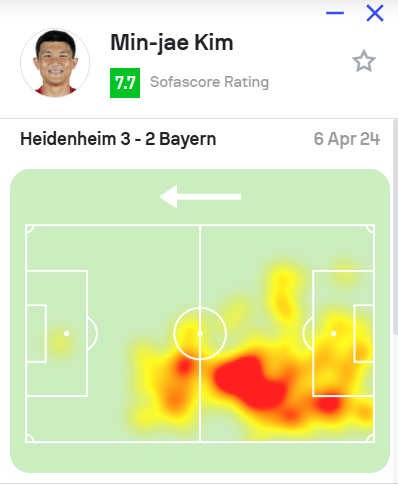How Stats Are Warping the Way We Watch Football
You’d be surprised how many opinions about a footballer’s performance now hinge on a number between 6.3 and 8.1. No context, no nuance, just a number. This is what happens when apps like Sofascore and FotMob go from being helpful tools to being the entire conversation. The overreliance on football stats is not just changing how people understand the game, it’s stripping it of its soul.
The Lazy Eye Test
There used to be a time when watching a full 90 minutes mattered. You’d watch a midfielder control the tempo, break up play, and dictate the rhythm. He might not score, assist, or complete a flashy dribble, but you knew, he ran the game. Now? Scroll Twitter after a match and you’ll see: “He had a 7.9 on Sofascore, clear MOTM” or worse, “6.4 from FotMob, dreadful showing.” That’s it. That’s the analysis.
Stats have replaced the eye test for too many fans. Rather than watching and forming an opinion, the numbers are taken as gospel. It’s lazy, and worse, it’s misleading.
When Numbers Lie
Not all stats are created equal. Expected goals (xG), progressive passes, pressures, they offer valuable insight. But they’re not absolute truths. In fact, they can be manipulated, especially when presented without context.
You’ve probably seen it. One fan tweets a chart with a midfielder’s pass completion and pressures per 90. Another replies with tackles and interceptions. Both are arguing opposite points with stats that, on the surface, seem definitive. It’s a classic case of cherry-picking.
Intentional use of cherry picking is driven by the rhetorical value of this technique. Essentially, this means people that use intentionally cherry picking in their arguments because doing so makes their arguments more persuasive, and helps them support their stance.
As pointed out by Effectiviology, cherry-picking stats is one of the easiest ways to push a biased narrative. When someone only shows you the numbers that support their argument, it paints a skewed picture. You can make a pretty average performance look elite, or make a solid player seem useless.
Why Passing Accuracy Doesn’t Always Tell the Truth
One of the most misused stats in football conversations is passing accuracy. It’s often thrown around as a stick to beat players with, “he only completed 76 percent of his passes, can’t be a top midfielder.” But that number, in isolation, tells you almost nothing about how well someone passed the ball.
Take Bruno Fernandes or Kevin De Bruyne. They consistently have lower passing accuracy than midfielders like Jorginho or Rodri. Does that mean they’re worse passers? Not at all. It means they try to do harder things.
Creative players don’t deal in safe zones. They’re the ones attempting risky through balls, switches into space, reverse passes between three defenders. They see things others don’t, and they take those gambles. Of course they’ll miss more often, that’s baked into the job. But when one of those passes lands, it splits a defence and puts a striker clean through. It’s worth the risk.
Someone can have a 92 percent pass completion rate and never once threaten the opposition. Another can sit around 75 percent and be the most dangerous player on the pitch. The numbers alone won’t tell you which is which.
This is where stats can mislead. Passing accuracy doesn’t account for pass difficulty, context, or intention. It treats a five-yard sideways ball the same as a defence-splitting pass through a crowded midfield. It values safety over invention. And that skews how people see creative footballers.
When fans use that number to dismiss players, they’re missing the point. The best playmakers aren’t tidy, they’re brave. They lose the ball trying to win the game, not keep the peace.
Arteta, xG, and the Danger of Excuses
Take Mikel Arteta at Arsenal. During their Champions League semi-final exit, he spoke about winning the xG battle. Domestically too, he often points to xG differences and marginal gains. There’s a logic to it, control the variables, maximise your chances. But it can also veer into dangerous territory.
“I don’t think there’s been a better team [than Arsenal] in the competition so from what I have seen, but we are out. We deserved much more I think in both games.”
Arteta quote after losing to PSG in the semi-final
In a Times column, it was noted that Arteta sometimes attributes losses to external factors, a red-hot keeper, the wind, or the expected data not aligning with the scoreline. That might wash with an analyst, but for players and fans, it can feel like an excuse. The game isn’t played in spreadsheets. It’s played in moments, decisions, instincts. Arsenal’s xG was higher yes, but it is glaringly obvious to anyone who watches Arsenal that they need a striker who can finish these chances. High xG with lower quality finishers will lead to one thing, underperforming your xG.
When stats become a shield from reality, they stop helping. They start blinding. And Arteta is refusing to see that in attacking areas Mikel Merino and Gabriel Martinelli are just worse players than Khvicha Kvaratskhelia and Ousmane Dembele.
Sofascore Culture and the Rating Obsession
The culture around post-match ratings has become bizarre. A fullback can pocket his winger, win every duel, and clear two off the line, but if he misplaces five passes? He’ll have a 6.2 and be labelled poor. Conversely, a forward might score a rebound, complete five passes, and offer nothing else, but he walks away with a 7.9 and praise for being clinical.
These ratings aren’t meaningless, but they shouldn’t be weighted like match reports. They’re automated, algorithm-driven assessments. And yet they’ve become currency. Players are memed or lauded based on these numbers. It’s like judging a book by its Goodreads rating without reading a single page.
What Stats Miss
There are things numbers can’t capture. Not really, anyway. Leadership. Positioning. Tactical awareness. The way a player communicates, organises, anticipates. You’ll never see a stat for dragging defenders out of shape to create space for a teammate. You won’t get a percentage for bravery under pressure or playing through pain.
Sometimes, the most effective players are those who blend into the background. They knit things together, cover for others, keep it simple. They’re not sexy on the stat sheet, but they win you matches.
Some Actions Don’t Show Up in the Stats
Not everything that matters in football can be measured. And even when it can be measured, not all stats tell the full story. That’s especially true with players who operate on the edge of the game’s structure, players who prevent problems before they even happen.
Take Ederson. Or really, any top sweeper keeper. These are goalkeepers who don’t just wait on their line to make saves, they actively manage space outside the box. They read through balls early, push up to intercept, and force strikers into rushed decisions before a shot even materialises.
But here’s the catch, that kind of proactive goalkeeping doesn’t boost your save percentage. It doesn’t show up in expected goals against (xGA). In fact, it often doesn’t show up anywhere in the raw stats. If Ederson steps 20 yards out to cut off a dangerous pass before it turns into a 1v1, there’s no line on the stat sheet for “anticipated danger and stopped it from existing.”
People look at shot-stopping numbers and say, “He’s not in the top five for saves per game.” Right, because he doesn’t let it get to that point. But unless you understand the tactical side of what he’s doing, the decisions he’s making in real time, you’ll never appreciate his impact just by scanning a stat page.
This is the key to using stats properly. It’s not about blindly quoting percentages or charts. It’s about context. It’s knowing what isn’t measured and what might be hidden behind a number. Understanding stats is really about understanding where their limits are.
A Tool, Not a Bible
Let’s be clear, this isn’t an anti-stats rant. Used properly, data adds depth. It shows patterns, trends, insights you might miss. It can challenge biases and bring balance to subjective takes. But that’s the key, used properly.
Stats should complement what we see, not replace it. They should provoke debate, not end it. When fans stop watching and only scroll, they lose the joy of football’s unpredictability. A clever flick, a smart foul, a risky run, they mean little in numbers, but they live in memory.
Why Watching Still Matters
I remember watching a match a year ago between Bayern Munich and Heideheim. Bayern Munich lost 3-2 to Heidenheim in one of the more chaotic Bundesliga matches of the season after leading 2-0 at half time. A lot went wrong for the visitors, but one of the most glaring issues was Kim Min Jae’s performance at the back. Watching live, it was obvious, his positioning was off, he stepped out recklessly, left acres of space behind him, and made poor decisions under pressure. For two of the goals, he was directly involved in the breakdowns that led to Bayern conceding.
And yet, the morning after, Sofascore had him rated at 7.7. That’s higher than several of his teammates who had done very little wrong.

How?
Look at his numbers and you’ll see why. Five clearances, three blocked shots, five tackles, six ground duels won, six aerial duels won. He completed 88 of 99 passes. He didn’t get dribbled past once. If you’re just looking at the data, he comes across as dominant. But the stats don’t show how often he was out of sync with the back line. They don’t show his poor body positioning or the panic his choices created around him.
He wasn’t unlucky, he was ineffective. And anyone watching could tell.
That’s where the stat sheet fails. It rewards volume, tackles made, passes completed, but it can’t measure decision quality in real time. It doesn’t penalise stepping up at the wrong moment or holding your line when you should drop. These are game-breaking errors that live outside the numbers.
You can look at Kim’s heatmap, his duels won, his pass percentage, they all look fine. But the only way to understand how much his actions hurt Bayern that day is to watch him. To feel the nerves every time he got drawn in. To see the gaps open behind him.
This is the disconnect. The stats tell one story, the eyes tell another. And when we trust the numbers too much, we risk getting it all wrong.
That disconnect is the problem. You can’t feel the rhythm of a match through numbers. You can’t understand pressure, tension, energy swings with heatmaps. You need to watch, listen, feel it. The same way you need to hear the roar after a big tackle or the groans after a misplaced pass. That’s football. Not a spreadsheet.
Reclaiming Football from the Stat Sheet
We’re not going to escape stats. Nor should we want to. But we do need to reset how we use them. Apps like Sofascore and FotMob are excellent for post-match breakdowns. But they’re not holy writ. They’re one piece of the puzzle.
Football isn’t a science experiment. It’s flawed, emotional, often illogical. That’s why we love it. That’s why we should be wary of reducing it to numbers on a screen. Games are often low scoring and can come down to moments of magic, or, heaven forbid, a bit of luck!
Watch the game. Form your own opinion. Don’t listen to tacticos. Then check the stats if you want. But don’t let them be the full story, because they rarely are.








